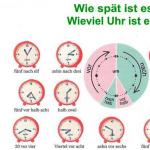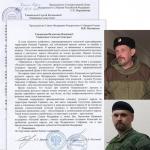Geometric meaning of the module and argument of an analytic function. Let the function w=f(z) is analytic in some domain D. Let us choose an arbitrary point and draw through it an arbitrary smooth curve lying entirely in D. Function f(z) displays the area D complex plane ( z) per region G complex plane ( w). Let a point be mapped to a point, and a curve be mapped to a curve. Let us denote by the angle made by the tangent to at the point with the axis Ox, and through - the angle made by the tangent at the point with the axis Ou. Since the function f(z) analytical, then there is a derivative at any point in the region D. Let's assume that in D. The derivative can be represented in exponential form, i.e. write it in the form:
Let us choose a method of striving in which the points lie on the curve. Then the corresponding points Complex numbers and on the plane will be represented by vectors secant to the curves and, respectively, and and are the lengths of the secant vectors, and and are the angles formed by these vectors and the positive axes. When these secant vectors become tangent to the curves and at points and . From equality (10) it follows that , i.e. the derivative argument has the geometric meaning of the difference between the angle of the tangent vector of the curve and the angle of the tangent vector. Since the derivative does not depend on the method of passing to the limit, it will be the same for any other curve passing through the point. In other words, arcs passing through a point z 0 on surface z when displayed w=f(z) rotate through the same angle on the plane w. When the angle between any curves on the plane ( z), passing through a point z 0, is equal to the angle between the curves and on the plane ( w), then this is called a property preservation (conservatism) of angles.
Similarly, from equality (10) we obtain: , i.e. up to quantities of a higher order of smallness, the equality holds: .
The last relation also does not depend on the method of choosing the curve and its geometric meaning is that when mapping is carried out by an analytical function that satisfies the condition, infinitesimal linear elements (infinitesimal arcs) are transformed in a similar way, and the modulus of the derivative is called similarity coefficient. This property of this mapping is called the property constant stretch, That's why k also called stretch factor. They say that when k>1 – stretching, and when k<1 – сжатие.
Definition of conformal mapping and basic properties. Definition 17. One-to-one area mapping D complex plane ( z) per region G complex plane ( w) called conformal, if it is at all points z D has the property of maintaining angles and constant stretching.
Theorem 6. In order for the complex function w=f(z) conformally mapped the area D plane ( z) per region G plane ( w), it is necessary and sufficient for it to be analytical in D and not at any point in the region D.
□ Necessity. Let's assume. what is the function w=f(z) performs conformal mapping. By definition, this means fulfilling the properties of preserving angles and constant stretching. Let's take it on a plane z arbitrary point z 0 and in its vicinity there are two points: z 1 And z2. On surface w they will correspond to points w 0 , w 1 , w 2
With an accuracy of up to infinitesimal quantities, the following relations will be satisfied: , and from the constancy of the angles it follows: . From the equality for the arguments it follows that the angles are equal not only in absolute value, but also in direction. As a result we get: .
Thus, from the last two equalities it follows, accurate to infinitesimal quantities, that the following equalities are satisfied: . Due to the arbitrariness of the choice of point z 0 and points z 1 ,z 2 from its vicinity it follows that there exists Adequacy. Let the derivative exist and not be equal to zero in the region D, then from the geometric meaning of the derivative it follows that the properties of conservation of angles and constancy of extension are satisfied, and this, by definition, means that the function carries out a conformal mapping. ■
Conformal mapping is used to solve problems in mathematical physics, hydrodynamics and aerodynamics, elasticity theory, and the theory of electromagnetic and thermal fields. The main task of the theory of conformal mapping is to find the function of a complex variable w=f(z), which would display a given area D plane z to a given area G plane w. The theorem plays an important role in solving this problem.
Theorem 7. Any simply connected region D complex plane z, the boundary of which consists of more than one point can be mapped conformally onto the interior of the unit circle<1 комплексной плоскости w.(no proof).
This theorem implies the possibility of a conformal mapping of a given region D to a given area G, if the boundary of each region consists of more than one point. Then, mapping these areas onto auxiliary circle <1, мы получим искомое отображение. Конформное отображение многосвязной области на односвязную область невозможно, но в ряде случаев возможно конформное отображение областей одинаковой связности. Рассмотрим два конформных отображения.
Linear display. Linear is a mapping carried out by a linear function where a And b- complex numbers.
Such a mapping is one-to-one and conformal on the entire complex plane since the Linear mapping leaves two points fixed:
Let's imagine a linear mapping in the form of three simplest ones.
1) Transformation of the rotation of the entire z plane by an angle around the origin:
2) Similarity transformation with the center of similarity at the origin, i.e. stretching at >1 and compression at 0< <1:
3) Parallel transfer to vector b:
Example 4. Find a function that displays a triangle with given vertices z 1 =-1, z 2 =i, z 3 =1 into a triangle with vertices w 1 =0, w 2 =-2+2i, w 3 =4i.
Solution. Let us construct the required function as a superposition of three elementary transformations.
1) - turn by an angle counterclockwise;
2) - double stretch;
3) - shift up two units;
The required function has the form:
Fractional linear mapping. Fractional linear function, where a,b,c,d- complex numbers are implemented fractional linear mapping extended complex plane z w. Let's find the derivative: if .
Definition 18. Points z 1 And z 2 are called symmetrical about the circle, if they lie on the same ray passing through the points z 1, z 2 and point z 0 , and .
Inversion relative to a circle is a transformation of the extended complex plane onto itself that takes each point z 1 plane to point z 2, symmetrical about this circle. Let's consider the mapping defined by the function and denote Using the property of the module, we can write: . It follows that the mapping in question is an inversion with respect to a circle of radius R, centered at the origin followed by a mirror image relative to the real axis.
By analogy with a linear mapping, let us imagine a fractional linear mapping as a superposition of simple transformations. Let's first select the whole part of the fraction:
The simplest transformations will be the following:
1) parallel transfer to: ;
2) inversion transformation relative to a circle of radius R centered at the origin followed by a mirror image about the real axis: ;
3) rotation relative to the origin: ;
4) parallel transfer to: .
Example 5. Find the area into which the circle will go under a linear-fractional mapping.
Solution.
This will be the circle that is obtained after the following transformations:
1) move 1 down:
2) inversion relative to , the direction of the bypass will change:
3) rotate 90 degrees:
4) move 1 down:
Properties of fractional linear mapping. Without proof, we formulate the following properties.
1.Conformity. The linear fractional function conformally maps the extended complex plane z to the extended complex plane w.
2. Uniqueness. There is a unique linear fractional function that is given three different points z 1 ,z 2 ,z 3 plane z displays at three different points w 1, w 2, w 3 plane w and this mapping is given by the equality: .
3.Circular property. With a fractional linear mapping, the image of any circle in the broad sense is a circle (in the broad sense, i.e. a circle or any straight line).
4. The principle of displaying boundaries. With fractional linear mapping, an area lying inside a circle is transformed into an area lying either inside or outside the transformed circle (the boundary is mapped to a boundary).
5. The principle of Riemann-Schwartz symmetry. With a fractional linear mapping, points that are symmetrical with respect to a circle are mapped to points that are symmetrical with respect to the transformed circle (symmetry in the sense of inversion).
Example 6. The upper half-plane of the plane is specified z and an arbitrary point z 0. Find a function that maps it to the unit circle of the plane w so that z 0 displayed in the center of the circle.
Solution.
Let , then according to the principle of mapping boundaries, the real axis on the plane z will be mapped into a circle of unit radius. According to the property of symmetry, a point will be mapped to a point. Thus, taking this into account, we will construct a function. If we consider the points z, lying on the real axis, and these are points of the form: , then the equalities will be satisfied for them: , because they are all equidistant from a point lying on the real axis, i.e. we have that all points of the real axis will be mapped to all points of the unit circle. Hence we find that if we consider the module, the required mapping will have the form: .
Solve another linear fractional mapping problem and insert both into the first module!
Lecture No. 4.
Geometrically, a function of a complex variable w=f(z) specifies the display of a certain set z– planes to a certain set w-plane. Dot wÎ G called way points z when displayed w=f(z), dot zÎ D – prototype points w.
If everyone z only one value matches w=f(z), then the function is called unambiguous (w=|z|,w=,w= Re z etc.) If some z matches more than one value w, the function is called polysemantic (w= Arg z).
If (i.e. at various points in the area D function takes on different values), then the function w=f(z) is called unifoliate in area D.
In other words, the univalent function w=f(z) one-to-one maps the area D on G. With single-sheet display w=f(z) inverse image of any point wÎ G consists of a single element: : . That's why z can be considered as a function of a variable w, defined on G. It is designated and called inverse function .
If in the area D there is at least one pair of points, then the function f(z) are called multileaf in area D.
If display w=f(z) is multileaf on D(For example, w=z n), then in this case some values wÎ G matches more than one point zÎ D:f(z)=w. Therefore, the inverse mapping is not single-valued, it is a multi-valued function.
Single digit on area D function w=f(z) is called branch of a multivalued function F, if value f at any point zÎ D matches one of the values F at this point.
In order to isolate single-valued branches of a multi-valued function, proceed as follows: area D divide functions into domains of univalence w=f(z) so that no two of the regions have common interior points and so that each point zÎ D belonged to one of these areas or the border of some of them. In each of these domains of univalence one defines a function inverse to w=f(z). It is the single-valued branch of the multi-valued function.
The concept of conformal mapping
Example. Find the stretch coefficient and rotation angle at a point z=2i when displaying .
■ Find the derivative and its value at a given point.
Stretch ratio k equal to the modulus of the derivative: .
Angle of rotation j is equal to the argument of the derivative. The point lies in the fourth quarter, therefore, . ■
Example 3.5. Determine which part of the plane when displayed w=z 2 is stretched, and which one is compressed.
■ Finding the derivative w¢=2 z. Tension factor at any point z equals k=|w¢( z)|=2|z|. The set of points in the complex plane for which k>1, that is 2| z|>1 or , forms part of the plane, which is stretched when displayed. Therefore, when displaying w=z 2, the outside of the circle is stretched, and the inside is compressed. ■
Display w=f(z) is called conformal (i.e., preserves its shape) at a point if it preserves the angles between curves and has the property of constant extension of the neighborhood of the point.
Any mapping established by means of an analytic function f(z) is conformal at all points where .
The mapping is called conformal in the region , if it is conformal at every point of this region.
A conformal mapping in which the direction of reference of the angles is preserved is called conformal mapping of the first kind . A conformal mapping in which the direction of angles is reversed is called conformal mapping of the ΙΙ genus (For example, ).
In the theory and practice of conformal mappings, two problems are posed and solved.
The first task is to find the image of a given line or area under a given mapping - direct task .
The second is to find a function that maps a given line or area to another given line or area - inverse problem .
When solving a direct problem, it is taken into account that the image of a point z 0 when displayed w=f(z) is a point w 0 , such that w 0 =f(z 0), that is, the result of the substitution z 0 in f(z). Therefore, to find the image of a set, you need to solve a system consisting of two relations. One of them specifies the mapping function w=f(z), the other is the equation of the line, if the problem of finding the image of the line is being solved, or the inequality that determines the set of points of the preimage, if the problem of mapping areas is being solved. In both cases, the solution procedure is reduced to eliminating the variable z from two given ratios.
Rule 3.3. To find the image of the line given by the equation F(x,y)=0 (or explicitly y=j(x)), when displaying w=f(z) necessary:
1. Select the real and imaginary parts of the function f(z): u=Re f(z), v=Im f(z).
2. Exclude from the system X And u. The resulting relationship is the equation of the image of this line.
Rule 3.4. To find the image of a given line when displaying w=f(z) necessary:
1. Write the equation of the line in parametric form z=z(t) or in complex form.
2. Depending on the type of line equation, consider the corresponding case:
If the line is given in parametric form, substitute the expression z(t) V w=f(z);
If the line is given in complex form, then express z from w=f(z), that is, and . Then you should substitute z and in the equation of the line. The resulting relationship is the equation of the image of this line.
Rule 3.5. To find an image of a given area, you should use one of two methods.
First way.
1. Write down the equation of the boundary of this area. Find the image of the boundary of a given area using rules 3.3 or 3.4.
2. Select an arbitrary internal point of a given area and find its image under the given mapping. The region to which the resulting point belongs is the desired image of the given region.
Second way.
1. Express z from the ratio w=f(z).
2. Substitute what you received in step 1. an expression in an inequality that defines a given region. The resulting ratio is the desired image.
Example. Find the image of a circle | z|=1 when displayed using a function w=z 2 .
■ 1 way(according to rule 3.3).
1. Let z=x+iy, w=u+iv. Then u+iv =x 2 -y 2 +i 2xy. We get:
2. Let's exclude X And at from these equations. To do this, let’s square the first and second equations and add:
u 2 +v 2 =x 4 -2x 2 y 2 +y 4 +2x 2 y 2 =x 4 +2x 2 y 2 +y 4 =(x 2 +y 2) 2 .
Taking into account the third equation of the system, we obtain: u 2 +v 2 =1 or | w| 2 =1, that is | w|=1. So, the image of the circle | z|=1 is a circle | w|=1, traversable twice. This follows from the fact that since w=z 2 then Arg w=2Arg z+2pk. So when the point z describes a complete circle | z|=1, then its image describes the circle | w|=1 twice.
Method 2(according to rule 3.4).
1. Let us write the equation of the unit circle in parametric form: z=e it (0£ t£2 p).
2. Let's substitute z=e it in ratio w=z 2: w=e i 2 t=cos2 t+i sin2 t. Therefore, | w| 2 = cos 2 2 t+sin 2 2 t=1, that is | w|=1 – image equation. ■
Example. Find the equation of the image of a line y=x when displayed w=z 3 .
■ Since the curve is given explicitly, we apply rule 3.3.
1. w=z 3 =(x+iy) 3 =x 3 +3x 2 iy+3x(iy) 2 +(iy) 3 =x 3 - 3xy 2 +i(3x 2 y-y 3).
2. In the resulting system we substitute y=x: Excluding X from these equations, we get v=-u.
So, the image of the bisector of the I and III coordinate angles of the system xOy is the bisector of the II and IV coordinate angles of the system uOv. ■
1. Linear function
Linear function called a function of the form
w=az+b, (4.1)
Where A, b- complex constants.
This function is defined by , . Therefore, if , then the linear function produces a conformal mapping of the entire plane of the complex variable. In this case, the tangents to all curves are rotated by the same angle Arg a, and the tension at all points is equal. If a= 1, then there is no stretching or rotation. In this case we get w=z+b. This mapping shifts the entire plane by a vector.
In the general case, moving to the exponential form of writing a complex number, we obtain. Therefore, a linear mapping is a composition of three geometric transformations:
w 1 =rz- similarity with coefficient r=|a|;
w 2 =e i j w 1 =rze i j- turn at an angle j=arg a around the point ABOUT;
w=w 2 +b=re i j z+b- parallel transfer to a vector.
Therefore, the mapping w=az+b changes the linear dimensions of any plane figure in | a| once, rotates this figure by an angle j=arg a around the origin and shifts it in the direction of the vector by its value.
A linear mapping has a circular property, that is, it maps circles z-planes in a circle w-plane (and vice versa); converts straight lines into straight lines.
Example. Find the image of the axis OU when displayed w=2iz-3i.
■ 1 way(according to rule 3.4). We choose the axis equation in parametric form.
1. Since in real form the equation of the axis Oy: x=0, -¥<y<+¥, то в комплексной форме запишется как z=iy, -¥<y<+¥. Это параметрическое уравнение, в качестве параметра выбран at.
2. Let's substitute z=iy into expression w=2iz-3i: w=-2y-3i, -¥<y<+¥. Это уравнение образа в параметрической форме (at- parameter). Having isolated the real and imaginary parts, we obtain the image equation in real form: u=-2y, v=-3 or v=-3, -¥<u<+¥. Это есть уравнение прямой в плоскости uOv, parallel to the real axis.
Method 2. We use the circular property of a linear transformation - the image of a straight line is a straight line. Since a straight line is defined by specifying two points, it is sufficient on the axis OU select any two points and find their images. The straight line passing through the found points will be the required one. Let's select points z 1 =0, z 2 =i, their images w 1 =-3i, w 2 =-2-3i when mapped, lie on the line Im w= -3. Therefore, the image of the axis OU is a straight line v=-3.
3 way(geometric). From the relation w=2iz-3i follows that a=2i, b=-3i, |a|=2, . This means that the given straight line (axis OU) must be rotated by an angle relative to the origin, and then shifted down 3 units. Stretching by 2 times does not change the geometric appearance of the original line, since it passes through the origin. ■
Example. Find some linear function representing a circle | z-i|=1 per circumference | w- 3|=2.
■ The posed problem is the inverse problem of the theory of mappings - given a given image and preimage, find the corresponding mapping. Without additional conditions, the problem does not have a unique solution. Let us present a geometric solution.
1. Move the center of the circle to the origin. To do this, we apply the mapping w 1 =z-i.
2. In plane w 1 let us apply a mapping that gives a 2-fold stretch, that is w 2 =2w 1 .
3. Shift the circle 3 units to the right: w=w 2 +3. Finally we get: w=2(z-i)+3, w= 2z+3-2i– the required function.
You can choose a different order for performing geometric operations - do not shift first, but rotate or stretch. ■
2. Fractional linear function
Fractional linear called a function of the form
Where a, b,c,d- complex numbers such that , .
Properties of fractional linear transformation
1°Conformity
Display w=L(z) is conformal at all endpoints of the complex plane except .
2° Circular property
The image of a straight line or a circle in a fractional linear mapping w=L(z) is a straight line or a circle (and the image of a straight line can be either a circle or a straight line, and the image of a circle can be both a straight line and a circle). It is easy to establish that when displaying w=L(z) all straight lines and circles passing through the point go into straight planes ( w), and all straight lines or circles not passing through the point d, - in the circumference of the plane ( w).
3°Double relation invariance
The relation is preserved under a fractional linear mapping, that is, it is its invariant. This relationship is called double ratio of four points. Thus, the fractional linear transformation is uniquely determined by specifying three points and their images: . Using these pairs, you can find a fractional linear function using the formula:
This formula can also be applied in the case when some of the numbers z k And w k turn into ¥, if you use the rule: the difference in which the symbol ¥ occurs should be replaced by 1.
4°Maintaining symmetry
If points z 1 and z 2 are symmetrical about some line or circle g, then for any fractional linear mapping w=L(z) their images w 1 and w 2 will be symmetrical relative to the image g: .
Symmetry about a straight line is understood in the usual sense.
Points z And z* are called symmetrical about the circle |z-z 0 |=R, if they lie on the same ray emerging from the center of the circle, and the product of their distances from the center of the circle is equal to the square of its radius, that is
|z-z 0 |×| z*-z 0 |=R 2 . (4.4)
A point symmetrical to a point z 0 – the center of the circle is obviously the point at infinity.
5°Boundary traversal matching principle (displaying areas bounded by lines or circles)
If, in a fractional linear mapping, a straight line or a circle g turns into a straight line or circle g¢, then the area D, which is limited g, is transformed into one of two areas that are bounded by g¢. In this case, the principle of correspondence of border bypass takes place: if during some line bypass g region D turns out to be on the left (right), then with the corresponding traversal of the line g¢ region D¢ should also be on the left (right).
Example. Find the fractional linear function w=L(z), such that w(i)=2i, w(¥)=1, w(-1)=¥.
■ Let us denote z 1 =i, z 2 =¥, z 3 =-1 and w 1 =2i, w 2 =1, w 3 =¥. Let us apply formula (4.3), replacing the differences containing z 2 and w 3 to ¥:
Let's convert: - w-wi+ 2i- 2=wz-wi-z+i Û w(z+1)=z-2+iÛ is the required function. ■ :w =1 and Im w=0.
2. Now in accordance with paragraph 2. Rule 3.5, choose an arbitrary point, for example, z=-1О D. Its image under a given mapping is , lying between the lines Im w=1 and Im w=0. Therefore, the image of the given area will be strip 0< Imw<1. ■
3. Exponential function
Exponential function of a complex variablez=x+iy is called a function denoted by exp z(read "exponent" z") and defined by the formula
Properties exp z
1° If , then exp z=exp x=e x, i.e. on the real axis, the exponential function of a complex variable coincides with the exponential function of a real variable. Therefore, along with the notation exp z p, parallel to the real axis:
If, for example, , then .
8° The exponential function is analytic on , (exp z)¢=exp z.
Example. Find the real, imaginary part, modulus and principal value of the argument for a number e 2- i.
■ We use the definition of an exponential function of a complex variable. Let z=2-i, x=Re z=2, y=Im z=-1.
Then . Hence,
You can also use the addition theorem and Euler's formula (1.7) instead of the definition. ■
Displayw =exp z
CONFORMAL MAPPING (conformal transformation), a mapping of one region (in a plane or in space) to another region, preserving the angles between curves. The simplest examples of conformal mapping are similarity transformations and rotations (orthogonal transformations).
Conformal mapping is used in cartography when it is necessary to depict part of the surface of the globe on a plane (map) while preserving the values of all angles; examples of such conformal mappings are the stereographic projection and the Mercator projection (see Map projections). A special place is occupied by conformal mappings of some regions of the plane onto others; their theory has significant applications in aero- and fluid mechanics, electrostatics and elasticity theory. The solution to many important problems is easily obtained when the area for which the problem is posed has a fairly simple form (for example, a circle or half-plane). If the problem is posed for a more complex domain, then it turns out to be sufficient to conformally map the simplest domain onto the given one in order to obtain a solution to the new problem from a known solution. This is exactly the path N. E. Zhukovsky followed when creating the theory of an airplane wing.
Not all regions of the plane admit conformal mappings onto each other. For example, a circular ring bounded by concentric circles cannot be mapped conformally onto a ring with a different radius ratio. However, any two regions, each of which is bounded by only one curve (simply connected regions), can be conformally mapped onto each other (Riemann's theorem). As for areas bounded by several curves, such an area can always be conformally mapped onto an area bounded by the same number of parallel straight line segments (Hilbert’s theorem) or circles (Köbe’s theorem), but the sizes and relative positions of these line segments or circles cannot be set arbitrarily .
If we introduce complex variables z and w in the original and image planes, then the variable w, considered in the conformal mapping as a function of z, is either an analytic function or a function complex conjugate to the analytic one. Conversely, any function that is analytic in a given domain and takes different values at different points of the domain (such a function is called univalent) conformally maps this domain onto some other domain. Therefore, the study of conformal mappings of plane regions is reduced to the study of univalent analytic functions.
Any conformal mapping of three-dimensional regions transforms spheres and planes into spheres and planes and is reduced either to a similarity transformation, or to one inversion transformation and one similarity transformation performed sequentially (Liouville’s theorem). Therefore, conformal mappings of three-dimensional (and generally multidimensional) regions do not have such great importance and such diverse applications as conformal mappings of two-dimensional regions.
The beginning of the theory of conformal mapping was laid by L. Euler (1777), who discovered the connection between functions of a complex variable and the problem of conformal mapping of parts of a sphere onto a plane (for constructing geographical maps). The study of the general problem of conformal mapping of one surface onto another led K. Gauss (1822) to the development of the general theory of surfaces. B. Riemann (1851) formulated the conditions under which a conformal mapping of one region of the plane onto another is possible, but the approach he outlined was only substantiated at the beginning of the 20th century (A. Poincaré and C. Carathéodory). The studies of N. E. Zhukovsky and S. A. Chaplygin, who opened a wide field of applications of conformal mapping in aero- and hydromechanics, served as a powerful stimulus for the development of the theory of conformal mapping as a large branch of the theory of analytic functions.
Lit.: Goluzin G.M. Geometric theory of functions of a complex variable. 2nd ed. M., 1966; Markushevich A.I. Theory of analytic functions. 2nd ed. M., 1968. T. 2; Lavrentyev M.A., Shabat B.V. Methods of the theory of functions of a complex variable. 6th ed. M., 2002.
Let a single-valued function be defined in a certain domain and let the points and belong to the domain.
Definition. If there is a finite limit of the ratio when, according to any law, it tends to zero, then:
1) this limit is called derivative of a function at a point and is indicated by the symbol
2) in this case the function is called differentiable at the point.
All rules and formulas for differentiating functions of a real variable remain in force for functions of a complex variable.
Theorem. In order for a function to be differentiable at a point ![]() , it is necessary and sufficient that:
, it is necessary and sufficient that:
1) real functions and were differentiable at the point *);
2) at this point the conditions were met
 , (4.2)
, (4.2)
called Cauchy-Riemann conditions(C.-R.)or d'Alembert-Euler.
If the conditions are met ( C.-R.) the derivative of a function can be found using one of the following formulas:
Let us present two definitions that are of fundamental importance in the theory of functions of a complex variable.
Definition.Function called analytical in the field, if it is differentiable at every point in this region.
Definition.Function called analytical at the point, if it is analytic in some neighborhood of the point, i.e. if the function is differentiable not only at a given point, but also in its neighborhood.
From the above definitions it is clear that the concepts of analyticity and differentiability of a function in a domain coincide, but the analyticity of a function at a point and differentiability at a point are different concepts. If a function is analytic at a point, then it is certainly differentiable there, but the converse may not be true. A function can be differentiable at a point, but not be differentiable in any neighborhood of that point, in which case it will not be analytic at the point in question.
The condition for a function to be analytic in a domain is that the Cauchy–Riemann conditions are satisfied for all points in this domain.
Relationship between analytical functions and harmonic functions. Can any function of two variables serve as the real and imaginary part of some analytic function?
If the function is analytic in the domain, then the functions are harmonic, that is, they satisfy Laplace’s equation.
 And
And  .
.
However, if the functions are arbitrarily chosen harmonic functions, then the function ![]() , generally speaking, will not be analytical, i.e. the conditions for them will not always be met.
, generally speaking, will not be analytical, i.e. the conditions for them will not always be met.
You can construct an analytical function from one given harmonic function (for example, ![]() ), picking up another
), picking up another ![]() so that the conditions are satisfied. Conditions (4.2) allow us to determine an unknown function (for example,
so that the conditions are satisfied. Conditions (4.2) allow us to determine an unknown function (for example, ![]() ) by its two partial derivatives or, what is the same, by its total differential. Finding a harmonic function from its differential is the problem of integrating the total differential of a function of two variables, known from real analysis.
) by its two partial derivatives or, what is the same, by its total differential. Finding a harmonic function from its differential is the problem of integrating the total differential of a function of two variables, known from real analysis.
Geometric meaning of the module and argument of the derivative. Let the function be differentiable in the domain and . The function will map a plane point to a plane point, a curve passing through a point to a curve passing through (Fig. 4.1).
Derivative modulus  is the limit of the ratio of the infinitesimal distance between the mapped points and to the infinitesimal distance between their prototypes and . Therefore, the quantity can be considered geometrically as a stretching coefficient (if ) at a point when mapping a region into a region, carried out by the function
is the limit of the ratio of the infinitesimal distance between the mapped points and to the infinitesimal distance between their prototypes and . Therefore, the quantity can be considered geometrically as a stretching coefficient (if ) at a point when mapping a region into a region, carried out by the function
 |  |
At each point in the region in each direction the stretching coefficient will be different. For the derivative argument, we can write
where and are respectively the angles and that the vectors and form with the real axis (Fig. 4.1). Let the angles formed by tangents to the curve and at points and with the real axis. Then for , a , therefore ![]() defines the angle by which the tangent to the curve at point must be rotated to obtain the direction to the tangent to the curve at point .
defines the angle by which the tangent to the curve at point must be rotated to obtain the direction to the tangent to the curve at point .
If we consider two curves and , and , then the angles and (Fig. 4.1) between their tangents are, generally speaking, unequal.
Definition. A mapping of a domain to a domain having the properties of constant dilations () in any direction and conservation (or conservatism) of angles between two curves intersecting at point is called conformal(similar in small). The mapping carried out by the analytic function is conformal at all points at which .
EXERCISES
55. Show that the function is differentiable and analytic in the entire complex plane. Calculate its derivative.
Solution. Let's find and. By definition we have . Hence, ![]() .
.
 ,
,  ,
,
![]() Where
Where  ,
,  .
.
As can be seen, the partial derivatives are continuous throughout the plane, and the functions and are differentiable at each point of the plane. The conditions are met. Consequently, it is differentiable at every point of the plane, and therefore analytic on the entire plane. Therefore, the derivative can be found using one of the formulas (4.3):
Finally, the derivative can be found using the rules of formal differentiation: .
56. Find out whether the function is analytical:
Solution. a) Since, then, from where  . As can be seen, the first condition (4.2) is not satisfied for any and . Consequently, the function is not differentiable at any point in the plane, and therefore not analytic.
. As can be seen, the first condition (4.2) is not satisfied for any and . Consequently, the function is not differentiable at any point in the plane, and therefore not analytic.
b) We have . Function ![]() And
And ![]() are differentiable at every point of the plane, because their partial derivatives are continuous throughout the plane. But the conditions are not satisfied at any point in the plane, except for the point where all partial derivatives are equal to zero. Consequently, the function is differentiable only at one point, but is not analytic there, since by definition it requires differentiability in a neighborhood of this point.
are differentiable at every point of the plane, because their partial derivatives are continuous throughout the plane. But the conditions are not satisfied at any point in the plane, except for the point where all partial derivatives are equal to zero. Consequently, the function is differentiable only at one point, but is not analytic there, since by definition it requires differentiability in a neighborhood of this point.
Thus, the function is not analytic for any value. From the above example it is clear that the analyticity of a function at a point is a stronger requirement than its differentiability at this point.
57. Is there an analytical function for which ![]() ?
?
Solution. Let's check if the function is ![]() harmonic. For this purpose we find
harmonic. For this purpose we find
And  . From the last relation it follows that it cannot be a real, as well as an imaginary part of an analytical function.
. From the last relation it follows that it cannot be a real, as well as an imaginary part of an analytical function.
58. Find, if possible, an analytic function from its real part ![]() .
.
Solution. First let's check whether the function is ![]() harmonic. We find , ,
harmonic. We find , ,  ,
,  And
And  . A function that is harmonic on the entire plane is associated with the Cauchy-Riemann conditions, . From these conditions we obtain,
. A function that is harmonic on the entire plane is associated with the Cauchy-Riemann conditions, . From these conditions we obtain,  . From the first equation of the system we find it by integrating over , assuming constant.
. From the first equation of the system we find it by integrating over , assuming constant.
where is an arbitrary function to be determined. Let's find it from here  and equate it to the expression previously found: . We obtain a differential equation to determine the function
and equate it to the expression previously found: . We obtain a differential equation to determine the function ![]() , where
, where
So, . Then, i.e. at this point there is a rotation through an angle and forming an angle with each other, are respectively displayed in rays and forming an angle with each other ![]() . Therefore, at a point, the conformality of the mapping is violated due to the fact that the property of angle conservatism is violated: the angles are not preserved, but are tripled.
. Therefore, at a point, the conformality of the mapping is violated due to the fact that the property of angle conservatism is violated: the angles are not preserved, but are tripled.
Electrode systems with complex two-dimensional electrostatic fields can be calculated using the conformal mapping method. The main idea of this method is to replace complex fields with simple fields for which the solutions are known. Such simple fields include the fields of a flat or cylindrical capacitor away from their edges. The method of conformal mappings is a practical application of the theory of functions of a complex variable. A conformal mapping is a continuous mapping that preserves the shape of infinitesimal (infinitesimal) figures. For a conformal mapping, the property of constancy of angles and constancy of extensions is satisfied. The name comes from Late Latin - conformis– similar, continuous mapping that preserves the shape of infinitesimal figures: for example, b.m. the circle remains b.m. all around; the angles between the lines at the point of their intersection with each other do not change. The area of application of the conformal mapping method for calculating electric fields is two-dimensional electrostatic fields.
Conformal transformation maps each point z=x+j×y real calculation field, described by a complex plane, to a point w=u+j×v another complex plane, with a simpler field configuration. The main difficulty of the method is finding the type of function for a given real electrode system. In practice, when trying to find a conformal mapping function, they either use special catalogs of conformal mappings or search for it through successive trials.
Let's assume that we know the form of some transformation z=f(w) or reverse conversion w=f(z), which establishes a one-to-one correspondence between two complex planes with complex ( z) and simple ( w) field configuration. The conversion factor is the ratio dw/dz.
The following relations are used here:
 ,
,  . (2.94)
. (2.94)
Similarly we can write:
 . (2.95)
. (2.95)
Two complex numbers are equal if their real and imaginary parts are equal. Comparing the values of the conversion coefficient given in expressions (2.93) and (2.95), we can write:
Expressions (2.96) are known as the Cauchy-Riemann conditions. Using various forms of representing complex numbers, the conversion coefficient can be written as:
Where ![]() is the coefficient of change in the length of segments during transformation, and tg(j) = b/a(j is the angle of rotation of the segments during transformation). From the Cauchy-Riemann relations, we obtain:
is the coefficient of change in the length of segments during transformation, and tg(j) = b/a(j is the angle of rotation of the segments during transformation). From the Cauchy-Riemann relations, we obtain:
 (2.99)
(2.99)
From relations (2.97) – (2.98) it follows that the conformal transformation coefficient M is the relative electric field strength, and each of the functions u And v can be chosen as a potential on the new complex plane w=f(u,v). This conclusion can be verified in another way. If the functions u And v can be chosen as a potential, then each of them must satisfy the Laplace equation: D u=0 and D v=0. This can be verified by directly re-differentiating the Cauchy-Riemann conditions. Let us differentiate the first condition with respect to X, and the second one at; add up the result; Let's move all significant derivatives to the left side of the notation and leave zero on the right:
; ; . (2.100)
From the resulting expression it follows that the function u satisfies the Laplace equation (1.25), (1.30) and can be taken as a potential. Let's differentiate the 1st condition with respect to at, and the 2nd - by X:
; ; , (2.101)
those. and function v also satisfies Laplace's equation and can also be taken as a potential. Since the force and equipotential lines on the plane z=f(x,y) are mutually perpendicular, and the conformal transformation leaves unchanged the angles between the lines at the point of their intersection, then from (2.97) ¸ (2.101) it follows that if the function u taken, for example, as a potential, then the line with v=const – is a line of force. If v– potential, then u=const – power line. Which of the functions u or v is a potential, and which is a line of force, should be determined from the analysis of the conformal transformation of the field on the original plane z=f(x,y) in a field on a plane w=f(u,v). Any function z=f(w)(or w=f(z)) gives us a solution to any problem in electrostatics. You can come up with an arbitrary function, find solutions for it, and then select the appropriate electrode system for the solutions found. Many solutions to electrostatic problems were found using this method (backwards).
When finding the electric field strength using the conformal mapping method, the following important circumstance should be taken into account. The electric field pattern is completely determined by the geometric parameters of the electrode system, regardless of the spatial scale and applied voltage. Therefore, the field can be described by intensity per unit voltage or length. Expressions (2.97)-(2.98) represent just such relative tension. To obtain the actual voltage, it is necessary to take into account the actual applied voltage and the actual distance between the electrodes. This is done by multiplying expressions (2.97)-(2.98) by the scale factor K m. Let the distance between the electrodes in the plane w equals u 2 -u 1 (v 2 -v 1), if the functions u or v, respectively. Then the scale factor takes the form:
K m= U/(u 2 -u 1) or K m= U/(v 2 -v 1). (2.102)
Cylindrical capacitor. Although the calculation of the electrostatic field of a cylindrical capacitor is given in §2.5, we consider it as an example of the application of the conformal mapping method. Field of a cylindrical capacitor (field of two concentric circles) on a plane xy can be mapped to a uniform field (the field of a parallel-plate capacitor) by the following transformation:
z = e w; x + j×y = e u+jv = e u(Cos v+j×Sin v).
Let us separate the real and imaginary parts:
Straight line on a real plane z, passing through the origin with an angle of inclination to the axis X equal v=const becomes a straight line on the plane w, parallel to the x-axis.
At u= const on the plane w a system of straight lines parallel to the ordinate axis is obtained. On surface z they correspond to a system of concentric circles. It is obvious that the lines with u= const should be taken as potential lines, and v- beyond the field lines. We will calculate the tension using formula (2.97):
![]()




Length of a converted small segment when transferred from a plane z to the plane w changes to 1/ r times where r– distance to the center of the circles. The farther from the center, the smaller the coefficient of change in the lengths of the segments. The transferred segment is rotated by angle j = arctg(- y/x). The angle between the ray coming from the origin to the middle of the converted segment and the axis X becomes equal to zero. All radii on z- planes turn into w- planes in a line parallel to the axis u. Scale factor
Tension
 (2.103)
(2.103)
The resulting formula (2.103) coincides, as one would expect due to the uniqueness theorem, with expression (2.18) obtained using the Ostrogradsky-Gauss theorem.
Field inside a right angle formed by two planes
As another example of the application of the method of conformal mappings, let us consider a field formed by two infinite conducting mutually perpendicular planes. It is obvious that such an electrode system has translational symmetry with an infinitesimal translation step along the planes and a symmetry plane passing at an angle of 45° to each of the planes. Such a field is reduced to a two-dimensional field, and to determine its parameters it is enough to calculate the characteristics of the field between one of the planes and the plane of symmetry. For two-dimensional fields, the conformal mapping method can be applied. Field in z– a plane perpendicular to the line of intersection of charged planes, shown in Fig. 2.20a. Behind the axles X And at lines of intersection of charged planes with z– flat. The field inside the right angle formed by two planes is transformed into a uniform field by the transformation w = z 2. Let's show this:
w= u+jv = z 2 = (x+jy) 2 = x 2 + j 2xy – y 2 ; u = x 2 – y 2 ; v = + j 2xy.
At u= const lines parallel to the axis v on surface w, are transformed into a family of equilateral hyperbolas x 2 – y 2 = A 2 on plane z. Axis 0 X is the real (focal) axis of hyperbolas, and the axis at its imaginary axis. A straight line passing through the origin at an angle of 45° to the axis X (u = 0; y = x), represents the line of intersection z– a plane with a plane of symmetry and is an asymptote of hyperbolas. Angle of intersection of hyperbolas with the axis X equal to 90°, i.e. function lines u=X 2 -at 2 perpendicular to the equipotential line X(surface of the charged plane X).
Functions v = 2xy at different values v describe another family of equilateral hyperbolas whose axes X And at are asymptotes, and the line at = X is the focal axis. Figure 2.20a shows hyperbolas with v= 4, 16, 36. When v= 0 hyperbola degenerates in the coordinate axis X And at, which coincide with the charged planes. Since the surface of charged planes is a surface of the same potential, it is obvious that it is the function v must be taken as a potential function on the plane w. In this case the function u represents a force function. The field of two infinite mutually perpendicular planes (axis X And at on z– plane) turns into a uniform field of an infinite charged plane (axis v on w– planes).
Conformal transformation, while preserving the shape of infinitesimal figures, can significantly change the shape of finite figures. An example of such a change is the transformation of a square abcd with coordinates A(0,8;0,8), b(0,8;4), c(4;4), d(4;0.8) on z- planes into a curvilinear quadrilateral a¢b¢c¢d¢ with coordinates a¢(0;1,28), b¢(-15,36;6,4), c¢(0;32), d¢(15.36;6.4) on w- planes.
Let us determine the relative strength of the electrostatic field of the charged planes in Fig. 2.20a. Of the two formulas (2.97) and (2.98), we will use (2.98) to determine the tension, since it is the function v = 2xy describes a system of equipotential surfaces (lines). Linear conversion factor:
![]() , (2.104)
, (2.104)
The length of the converted small segment when transferred from z- planes on w- plane increases by 2 r times where r=X 2 +at 2 – distance at z- plane from the origin to the center of the segment. The transferred segment is rotated by an angle j = arctan( y/x). There is a doubling of the angle between the ray going from the origin to the middle of the segment and the axis X. Scale factor K m = U/(v 2 -v 1) = U/(2x 2 y 2 -2x 1 y 1). The field strength is determined by multiplying the relative strength by the scale factor: E=E¢×K m. Let the scale factor be K m=100 v/m. Let us determine the field strength at two points on the charged plane: closer to the angle of intersection of the planes n 1(1;0) and distant from it n 2 (5;0).
V/m, ×v/m.
The closer to the corner, the lower the field strength. This result could be expected from the field picture in Fig. 2.20: the distance between the equipotential lines decreases with distance from the corner. Any depression (dent, depression, cavern, crack, etc.) on the surface of the electrode can be approximately described by the problem considered. Then, taking into account the results of the previous paragraph, we can conclude: near the tip or protrusion, the electric field strength increases, and near the depression or hole it weakens. A similar picture in Fig. 2.20a of the behavior of force and equipotential lines is observed near the branching point of the field from two charges of the same name (§2.11).
Field at the edge of a flat capacitor (Rogowski profile)
Let's place the origin of coordinates at z- planes so that the axis X was parallel to the planes of the capacitor plates and was at the same distance from them a. Axis at perpendicular to the plates and passes through their edges. The function of mapping the field at the edge of a flat capacitor into a uniform field was obtained by Yu. K. Maxwell in 1881 in the form:
![]() . (2.105)
. (2.105)
After separating the variables we get:
![]()
![]()
At v I= 0, y = 0, ![]() . At v II= p, y= a,
. At v II= p, y= a, ![]() .
.
Obviously, the potential function should be chosen as v.
![]() ,
, ![]()

Considering that K m=U/(v II -v I) = U/p
 (2.106)
(2.106)
At u < -5 в области от v I=0 to v II=p, an almost uniform field with a strength is obtained U/a. At u®0 voltage at the electrode ( v=v II = p)increases strongly and tends to infinity as u=0. The highest tension in real systems does not vanish:
 . (2.107)
. (2.107)
At a finite thickness of the capacitor plate v¹p and the tension remains finite. Size v should be selected so that the equipotential surface coincides with the actual surface of the capacitor plate. Let v= 174° = 29p/30, then the ratio of the voltage at the edge of the electrode to the average voltage:
 .
.
It can be seen that even at a fairly blunt edge the tension increases sharply. This ratio can be made close to unity if the electrode surface is made in the form of an equipotential surface with v£ p/2. This electrode profile is called the Rogowski profile (Fig. 2.21c). At a distance A= p (the distance between the plates is 2p) it has the coordinate v= p/2 and for it x = u+1; y= p/2+ e u, i.e. at= p/2+ e (X-1) (2.108)
The Rogowski profile is of great practical importance in experiments on breakdown in a field close to uniform to eliminate the edge effect. There is a uniform field in the center of the device with Rogowski electrodes.
Field of split wires.
In high voltage power lines, the phase wire is split into several conductors in order to reduce losses of transmitted power due to corona discharge. To describe the split field
wires you can use the display function, where n –
the number of individual conductors into which the phase wire is split. To illustrate the method of conformal mappings, consider splitting into two wires ( n=2). (Note that this case can be solved quite simply using the image method)
Let the plane z perpendicular to the split wires. Let's select an axis X on z plane so that it passes through the axes of the wires. Let the axis y passes through the middle of the segment between the wires. The solution is greatly simplified if we find non-functions x,y=f(u,v), and the functions u,v = f(x,y). Separating the real and imaginary parts, we get:
 ,
, 
The equipotential lines correspond to the function u. To function u was equal to zero, the logarithm must be equal to zero, and the expression in square brackets must be equal to 1. Then the relation holds:
(X 2 +at 2) 2 = 2A 2 (X 2 -at 2)
This function passes through the origin z- planes. At u in the range -1.28< u < 0 на z- plane, circular areas are observed to the right and left of the axis at. At u£ -1.28 are practically points with coordinates X = -A And X = A. At u> 0 solutions are closed curves, which, with increasing u approaching the shape of circles. These curves represent potential field lines of two cylinders with charges of the same sign, i.e. fields of two wires with the same potential. The points on the surface of the wires are of greatest interest R 2 and R 1, in which, respectively, the highest and lowest field strengths are observed. Dot R 2 is located on the surface of the wire at the point most distant from the other wire and has coordinates:
 ,
, 
Taking into account the scale factor for point p 2 we obtain:
 . (2.109)
. (2.109)
At s®0, the electrode system turns into a system of two coaxial cylinders ( b=0, s=0) (see (2.18)):

Typically for a power line p ³ 200.
Self-test questions
1. Give the fundamental equations of Laplace in space, a homogeneous and plane-parallel field.
2. Give formulas for calculating the potential and field strength of a point charge. Determine the capacity of a single metal ball.
3. Give formulas for calculating the potential and field strength of a single infinitely thin straight wire of infinite length.
4. Where are the areas with maximum field strength of the coaxial cable. Find the optimal diameter of the inner core for a given size of the outer shell and the potential difference between them. Determine the linear capacitance of the coaxial cable.
5. Why are cables made with insulation from various types of dielectrics?
6. Explain the design of capacitor input and its purpose.
7. What is the overlay method, and what is partial capacitance?
8. What is an electric dipole, what are the characteristics of the dipole field? To explain what phenomena is the concept of a dipole used?
9. What are the similarities and differences between the fields of two like and unlike charges?
10. Graphically depict the field of two oppositely charged infinite axes. Give formulas for calculating such a system and indicate the points with maximum field strength.
11. What is the reflection method? Explain the essence of the method using the example of calculating the field parameters of a single wire above the ground.
12. Give a method for calculating the field parameters of a point charge located near a metal ball.
13. Determine the electric field strength on the surface of a single wire located above the ground.
14. How to determine the field parameters of a three-phase line?
15. Determine the maximum voltage of the ball gap.
16. Give a method for finding the parameters of the field created by a conductor of finite length.
17. Give a method for finding the parameters of the field created by a ring charge.
18. Give a method for finding the parameters of the field created by a charged disk.
19. How do the field parameters depend on the radius of curvature of the electrode surface? Why should the surfaces of high voltage electrodes be smoothed and ground?
20. Explain the essence of the conformal mapping method and list the sequence of calculations using this method.
21. What is a Rogowski profile?
22. How does a space charge arise and how does it change the characteristics of the electric field?
23. Which of the characteristics of the electric field is an analogue of energy?
24. Which of the characteristics of the electric field is an analogue of force?
25. For what purpose is the conductor of one phase split into several parallel conductors on power lines with a rated voltage of 330 kV and above? Indicate the points with maximum tension on the split wires. What are the distances between split conductors?
26. Where is the electric field strength near the surface of the earth higher: in a depression (hole, ravine) or on an elevation (hill, mound)? Explain your answer graphically and with calculations.
27. How does the electric field strength change at ground level under a single-circuit power line with horizontal phase wires?
28. Give an algorithm for calculating the ground capacitance of a three-phase overhead line.
29. For what purpose are ring screens installed on high-voltage devices?
30. Derive formulas for calculating the parameters of a cylindrical capacitor.


















